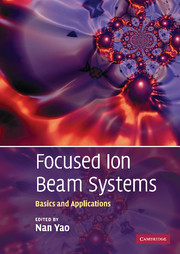Book contents
- Frontmatter
- Contents
- List of contributors
- Preface
- 1 Introduction to the focused ion beam system
- 2 Interaction of ions with matter
- 3 Gas assisted ion beam etching and deposition
- 4 Imaging using electrons and ion beams
- 5 Characterization methods using FIB/SEM DualBeam instrumentation
- 6 High-density FIB-SEM 3D nanotomography: with applications of real-time imaging during FIB milling
- 7 Fabrication of nanoscale structures using ion beams
- 8 Preparation for physico-chemical analysis
- 9 In-situ sample manipulation and imaging
- 10 Micro-machining and mask repair
- 11 Three-dimensional visualization of nanostructured materials using focused ion beam tomography
- 12 Ion beam implantation of surface layers
- 13 Applications for biological materials
- 14 Focused ion beam systems as a multifunctional tool for nanotechnology
- Index
- References
5 - Characterization methods using FIB/SEM DualBeam instrumentation
Published online by Cambridge University Press: 12 January 2010
- Frontmatter
- Contents
- List of contributors
- Preface
- 1 Introduction to the focused ion beam system
- 2 Interaction of ions with matter
- 3 Gas assisted ion beam etching and deposition
- 4 Imaging using electrons and ion beams
- 5 Characterization methods using FIB/SEM DualBeam instrumentation
- 6 High-density FIB-SEM 3D nanotomography: with applications of real-time imaging during FIB milling
- 7 Fabrication of nanoscale structures using ion beams
- 8 Preparation for physico-chemical analysis
- 9 In-situ sample manipulation and imaging
- 10 Micro-machining and mask repair
- 11 Three-dimensional visualization of nanostructured materials using focused ion beam tomography
- 12 Ion beam implantation of surface layers
- 13 Applications for biological materials
- 14 Focused ion beam systems as a multifunctional tool for nanotechnology
- Index
- References
Summary
Introduction
In this chapter, we consider some of the characterization possibilities that are typical and in some cases even unique to focused ion beam (FIB) and DualBeam® (FIB/scanning electron microscope (SEM)) instruments. It is well known that FIB based instruments may be used to section and provide analysis of the third dimension for subsequent SEM or FIB imaging. Following the preparation of any cross section, the steps to obtain serial sections are relatively straightforward. Why not, after opening up the inside of the bulk substrate by milling a trench and imaging a polished sidewall of that trench, polish off a thin layer of material, and open up a second surface for imaging? One can continue in the same fashion, and open up a third, a fourth, a fifth, etc., surface, and in so doing create a series of serial sections through a volume. In this manner, one may analyze a selected volume of the sample, instead of “just” a single cross-sectional surface. This type of analysis is “3D characterization,” and it constitutes the better part of this section. 3D characterization is more than a series of SEM images; it can equally be applied to FIB images [1], and even complete elemental maps (via energy dispersive spectrometry (EDS)) [2] or 3D crystallographic data (via electron backscatter diffraction (EBSD)) [3, 4].
- Type
- Chapter
- Information
- Focused Ion Beam SystemsBasics and Applications, pp. 126 - 145Publisher: Cambridge University PressPrint publication year: 2007



